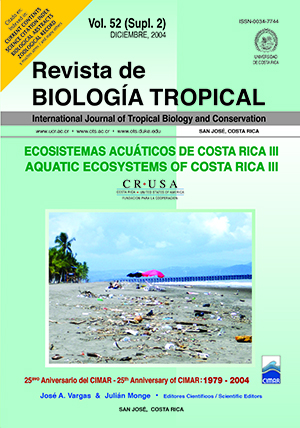Resumen
Los patrones de circulación oceánica, la estructura vertical de la columna de agua y la posición vertical de la termoclina son factores de gran importancia para comprender la distribución vertical de los organismos planctónicos en los océanos. Este trabajo estudia la hidrografía del Golfo Dulce, un fiordo tropical en el Pacífico Oriental Tropical (POT), y la posible influencia sobre dicho sistema del ENOS 1997-1998. Se seleccionó un total de cinco estaciones de muestreo, para las cuales se obtuvo, mensualmente, perfiles verticales de temperatura (ºC), salinidad (‰) y oxígeno disuelto (mg O2/l) durante un periodo de dos años. Los resultados muestran una fuerte estratificación vertical de la columna de agua asociada a la morfología de la cuenca del Golfo Dulce y a la incidencia del fenómeno ENOS. Además, se determinó que existen diferencias significativas en las características hidrográficas de las partes interna y externa de la cuenca del Golfo Dulce. Finalmente, se detectaron eventos bianuales de entrada de agua oceánica fría, con salinidad y concentraciones de oxígeno disuelto relativamente altas, a la cuenca. Estos eventos podrían estar asociados al sistema de afloramiento costero del Golfo de Panamá.Citas
Bougis, P. 1976. Marine Plankton Ecology. Elsevier, New York, N.Y. 355 p.
Brown, J., A. Colling, D. Park, J. Phillips, D. Rothery & J. Wright. 1989a. Seawater: its composition, properties and behaviour. Pergamon, Oxford. 238 p.
Brown, J., A. Colling, D. Park, J. Phillips, D. Rothery & J. Wright. 1989b. Ocean Circulation. Pergamon, Oxford. 165 p.
Coen, E. 1983. Climate, p. 35-46. In D. Janzen (ed.). Costa Rican Natural History. University of Chicago. Chicago, Michigan.
Córdoba, R. & J.A. Vargas. 1996. Temperature, salinity, oxygen and nutrient profiles at a 200 m station in Golfo Dulce, Pacific coast of Costa Rica. Rev. Biol. Trop. 44(Suppl. 3): 233-236.
Dessier, A & J.R. Donguy. 1985. Planktonic copepods and environmental properties of the eastern equatorial Pacific: seasonal and spatial variations. Deep Sea Res. 32(9): 1117-1133.
Dietrich, G. 1963. General Oceanography: an introduction. Interscience, New York, 588 p.
Hartmann, H.J. 1994. The Golfo Dulce Marine Environment: Review and Critical Assesment. Department of Biology of La Rochelle, University of La Rochelle, Charente-Maritime, France. 34 p.
Ikeda, T. 1985. Metabolic rates of epipelagic marine zooplankton as a function of body mass and temperature. Mar. Biol. 85: 1-11.
Lavaniegos, B. & E. Gonzalez-Navarro. 1999. Cambios en la comunidad de copépodos durante el ENSO de 1992-93 en el canal de San Lorenzo, Golfo de California. Ciencias Mar. 25(2): 239-265.
León-Morales, R. & J.A. Vargas. 1998. Macroinfauna of a tropical fjord-like embayment: Golfo Dulce, Costa Rica. Rev. Biol. Trop. 46(6): 81-90.
Longhurst, A. 1985. Relationships between diversity and the vertical structure of the upper ocean. Deep Sea Res. 32(12): 1535-1570.
Longhurst, A. & D. Pauly. 1987. Biological Communities of tropical Oceans, p. 63-105. In A.R. Longhurst & D. Pauly (eds.). Ecology of Tropical Oceans. Academic. San Diego.
Margalef, R. 1985. Primary production in upwelling areas: energy, global ecology and resources. Int. Symp. Upw. W. Afr. 5(1): 225-332.
NOAA. 2000. National Oceanographic and Atmospheric Agency. On line at: http://www.noaa.gov/
Philander, G. 1996. El Niño and La Niña, p. 72-87. In R.G. Pirie (ed.). Oceanography: contemporary readings in ocean science. Oxford Univ. New York, N.Y.
Quesada, M.A. 2001. Caracterización, composición, abundancia y biomasa del zooplancton en el Golfo Dulce durante el periodo 1997-1998. Tesis de Maestría, Universidad de Costa Rica, San José. 120 p.
Rattray, M. 1967. Some aspects of the dinamics of circulation in fjords. In G.H. Lauff (ed.). Estuaries. American Association for the Advancement of Science. Washington, D.C.
Reynolds, C.S. 1989. Physical determinants of phytoplankton succession, p. 9- 56. In U. Sommer (ed.). Plankton Ecology: Succesion in plankton communities. Springer. New York.
Richards, F.A. 1965. Anoxic basins and fjords. pp.: 611- 645 In J.P. Riley & G. Skirrow (eds.). Chemical Oceanography, Vol. 1. Academic. London.
Richards, F.A., J.J. Anderson, & J.D. Cline. 1971. Chemical and physical observations in Golfo Dulce, an anoxic basin on the Pacific coast of Costa Rica. Limnol. Oceanogr. 16(1): 43-50.
Riley, G.A. 1967. The Plankton of Estuaries, p. 316-326. In G.H. Lauff (ed.). Estuaries. American Association for the Advancement of Science. Washington.
Svendsen, H., R. Rosseland, S. Myking, J.A. Vargas, O.G. Lizano & E.J. Alfaro. 2004. A physical-Oceanographycal study of Golfo Dulce. Rev. Biol. Trop. 52 (Supl. 3B): 1-10.
Thamdrup, B., D.E. Canfield, T.G. Ferdelman, R.N. Glud, & J.K. Gundersen. 1996. A biogeochemical survey of the anoxic basin Golfo Dulce, Costa Rica. Rev. Biol. Trop. 44 (Suppl. 3): 19-33.
Thurman, H.V. 1996. Essentials of Oceanography. Prentice Hall, New Jersey, New Jersey. 400 p.
Tilman, D., S. Kilham & P. Kilham. 1982. Phytoplankton community ecology: the role of limiting nutrients. Ann. Rev. Ecol. Syst. 13: 349-372.
Umaña, G. 1998. Characterization of some Golfo Dulce drainage basin rivers (Costa Rica). Rev. Biol. Trop. 46(6): 125-135.
von Wangelin, M. & M. Wolff. 1996. Comparative biomass spectra and species composition of the zooplankton communities in Golfo Dulce and Golfo de Nicoya, Pacific coast of Costa Rica. Rev. Biol. Trop. 44 (Suppl. 3): 135-155.
White, J., X. Zang, L. Welling, M. Roman & H. Dam. 1995. Latitudinal gradients in zooplankton biomass in the tropical Pacific at 140ºW during the JGOFS EqPac study: effects of El Niño. Deep Sea Res. II 42(2-3): 715-733.
Wolff, M., H.J. Hartmann, & V. Koch. 1996. A pilot trophic model for Golfo Dulce, a fjord-like tropical embayment, Costa Rica. Rev. Biol. Trop. 44 (Suppl. 3): 215-231.
##plugins.facebook.comentarios##

Esta obra está bajo una licencia internacional Creative Commons Atribución 4.0.
Derechos de autor 2004 Revista de Biología Tropical


